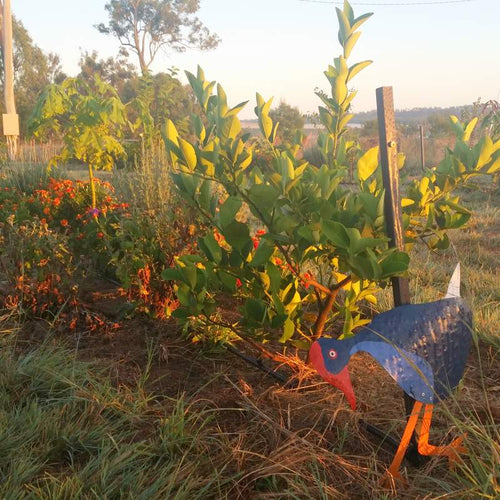Permaculture - Use small and slow solutions
In his book Permaculture: Principles and Pathways beyond Sustainability (affiliate link), David Holmgren, one of the founders of permaculture, has written about 12 design principles. The ninth permaculture principle is Use Small and Slow Solutions. In this post I summarise this chapter and give examples from my own experience.
| Nancy is small and it looks like halter training will be a slow process.... (OK I couldn't think of a photo to use and Nancy is cute) |
Small and slow solutions are important in an energy-constrained future
Generally large, fast solutions use more energy and are more expensive, which makes them accessible only to people and businesses with the appropriate resources. For most things there is an optimal size that is achievable with the resources available. On a small farm or backyard, this is usually the human scale and speed, things that can be lifted or moved or operated by one or several humans.
As the scale and speed increases, more machines are required and more energy to operate the system. I think its important to distinguish between setting up a system and maintaining a system. It may be appropriate to use considerable energy to set up a system, but the system itself is ideally small, slow and self-sustaining. For example, we couldn't have possibly built our driveway without the help of several earth-moving machines, but we hope that its now been redirected and shaped to reduce future maintenance requirements. Another example would be using earth-moving equipment to set up irrigation networks, that can then be operated by opening a hand valve.
Examples of small scale vs large scale
- It takes far less energy to produce food on a small scale, no need for tractors and trucks if you grow a little to feed just you and your family in a vegetable garden.
- Also milking one cow requires less infrastructure and equipment, and less transport again, compared to milking hundreds of cows in one place and then processing and distributing the milk.
- Smaller houses require less heating and cooling, less cleaning and maintenance, less furnishings and building materials compared to large houses.
- Several smaller cells can be more efficient than one large system, for example we have two small chest freezers rather than one large one, so we can turn one off when it gets empty. Also if one freezer stops working, we only lose half the food. This concept applies to numerous other examples, in particular, David mentions the complex food distribution system, which can easily be disrupted, as we saw in QLD when Brisbane, the hub, was flooded, and the food couldn't be distributed.
Examples of slow vs fast solutions
- If we associate slow with quality of production, things that are made slowly, such as homemade clothing or homemade bread are slower compared to buying the same article, but better quality and generally “fit for purpose” as they are custom-made for the application.
- Eating with the seasons can be slow too, but the first egg of spring or the first tomato of summer is tastier because we had to wait.
- Soaking and fermenting food takes a few days to be ready, but less effort than heating and cooking the same thing. For example, making fermented pickles takes a few minutes to put the ingredients in the jars and then three days to ferment, which is slower, but less effort compared to cooking and preparing vinegar pickles.
- My hybrid hugelkultur works by slowly decaying logs gradually building soil. We could have achieved the same result very quickly with earthmoving equipment and a truckload of soil. But all that work might have washed away in the next storm. This hugelkultur solution is being formed slowly by nature and will be more permanent.
- Cycling or walking around our property takes longer than driving, but gives an opportunity to observe changes in vegetation, soil, erosion, animal tracks, fences etc that would not be noticed when travelling by car. This is a form of multi-tasking, using the slower speed of the journey to achieve necessary observations as well as the purpose at the end of the journey.
- Mustering cattle on foot or horseback is slower than on motorbike, but the cattle are less stressed when they move at cow speed (which is naturally slow unless they are panicked).
- Perennial plants grow slowly and take longer to produce a yield, but when they do start to produce, they will yield annually with minimal maintenance requirements, compared to annual crops that produce quickly but require more care. This is a good example where a mixture of fast and slow solutions is useful.
- Using our milking machine is faster than hand-milking, but requires a connection to mains electricity. Hand-milking would be a slower, but simpler solution.
Find out more about Permaculture using these books (affiliate links):
And the other posts in this series:




















Leave a comment